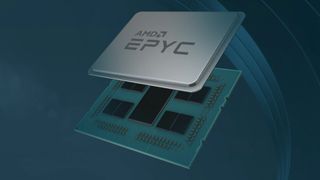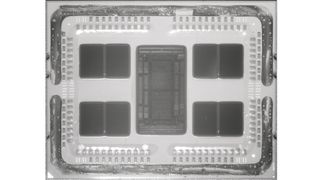AMD Epyc CPU with 39.5 billion transistors is a jaw-dropping sight under the microscope
Epyc pic...

Want to know what AMD’s 2nd-gen Epyc processors look like close-up? Well feast your eyes on the below image of one of these innovative server chips which is bristling with no less than 39.54 billion transistors.
The image of the Epyc processor under a microscope was provided by Hardwareluxx.de forum member OC_Burner, who has taken similar close-up chip shots in the past.

The IOD (Input/Output Die) contains 8.34 billion transistors in an area of 416 mm², compared to a Ryzen 3000 processor’s IOD which has 2.09 billion transistors in an area of 125 mm².
- We've chosen all the best AMD processors
- Best cheap processor deals in October 2019
- AMD vs Intel: which chipmaker does processors better?
The CCDs – or Compute Core Dies, home to the actual CPU cores and caches – boast 3.9 billion transistors in an area of 74 mm², the same as Ryzen 3000. There are eight CCDs and one IOD in an Epyc 2nd-gen (Rome) CPU.
PCIe boost
Focusing on Epyc’s much larger IOD (in comparison to consumer Ryzen), as Wccftech (which spotted the original story) observes, what’s interesting to note is that on both sides of the die, there are 128 PCIe lanes – but the possibility exists with PCIe Gen 4 to open up more lanes. In fact, up to 160 PCIe lanes, the extra lanes of which are already present but used by the Infinity Fabric links (the interconnect which hooks up the CCDs and IOD).
This possibility has previously been talked about, and there would be a performance trade-off in doing this, of course, in terms of reduced socket-to-socket bandwidth – but still, the option could be there for those who want to go that route.
As we’ve seen recently, Intel is taking AMD’s growing threat in the processor world more seriously, and Epyc server chips likely represent the biggest danger of all. Analysts have previously highlighted the potential of these heavyweight 7nm server chips, and AMD has already scored some big-name wins in terms of new clients including Google and Twitter.
Are you a pro? Subscribe to our newsletter
Sign up to the TechRadar Pro newsletter to get all the top news, opinion, features and guidance your business needs to succeed!
So given this, and the already obvious Ryzen 3000 threat, it isn’t exactly surprising to see Intel already slashing the prices across some of its processors, including Intel Xeon W CPUs and high-end desktop Cascade Lake-X models (Threadripper 3rd-gen is also incoming, of course).
- These are the best small business servers of 2019
Darren is a freelancer writing news and features for TechRadar (and occasionally T3) across a broad range of computing topics including CPUs, GPUs, various other hardware, VPNs, antivirus and more. He has written about tech for the best part of three decades, and writes books in his spare time (his debut novel - 'I Know What You Did Last Supper' - was published by Hachette UK in 2013).
Most Popular


